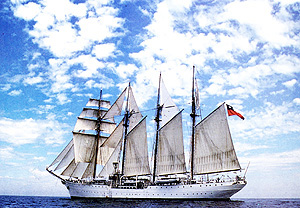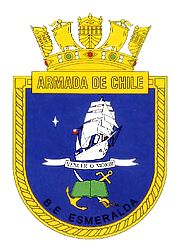Training Ship Esmeralda (VI)
- Año:1953
- Desplazamiento:3673 t
- Potencia de Maquinaria2610 HP
Armamento:
4 57 mm cannons
- Velocidad Máxima17.5 knots
- Eslora:113,1 Meters, include Bauprés
- Manga:13,1 Meter
- Puntal:8,6 Meter
- Calado:7 Meter
- Comandante Captain Pablo Lubascher Correa
Nombres anteriores


The Academy Vessel Esmeralda was bought from Spain. In 1946, the Spanish Navy ordered the construction of a vessel, hull Nº 32, to the Echavarrieta & Larrinaga Yards in order to replace the Academy Vessel Juan Sebastian de Elcano. The construction began in the same year.
On August 18, 1947, the yards were destroyed by an explosion at the Submarine Defense Base. The construction of the vessel was interrupted and the ship building company was in the edge of bankruptcy. The State of Spain took over the company, settled the debts and created the Sociedad de Astilleros de Cádiz, S.A. (Cadiz Shipyards Society).
However, the construction of the vessel remained paralyzed. The hull was unmasted in the slip and had been seriously damaged by the explosion.
For many years, Spain had imported thousands of tons of niter from Chile, to recover the agriculture industry that had been devastated by the Civil War. Spain had taken an installment plan contract from the Government of Chile, but was not able to pay the payments and interests on time.
On the last week of September, 1950, the Advisor of the Spanish Embassy in Chile, Eduardo Vianda and the Naval Attaché, Captain Leopoldo Boado y Endiza had an interview with the Chilean Naval Sub-Secretary, Rear Admiral Pedro Espina Ritchie, who was then informed of the inability of Spain to pay for the credit. However, Spain offered to pay the debt with manufactured products, being among them, goods of naval construction.
Rear Admiral Espina reported his interest in the unfinished Juan de Austria to the Commander in Chief of the Navy, Vice Admiral Carlos Torres Hevia. After several negotiations and the collaboration of the Ambassador of Spain in Chile, Jose Maria Doussinague, the President of Chile at that time, Gabriel Gonzalez Videla, authorized the purchase of the vessel.
The President's proposal was adopted by the Parliament, through the Act Number 10233, of December 27, 1951, which considered an acquisition budget of US$2,980,000.
After in situ studies and the modification of some technical specifications, the purchase contract for the Academy Vessel was signed in Madrid on October 23, 1952. The Rear Admiral Jesus Maria de Rotaeche y Rodriguez Llamas signed in representation of the shipyards society and the Ambassador of Chile in Spain, Luis Subercaseaux Errazuriz, signed in representation of the State of Chile.
On May 12, 1953, at 1330 hours, in synchronicity with the highest tide, the Academy Vessel was laid down from the slip of the Sociedad de Astilleros de Cadiz S.A.
The ceremony began with the Bishop Tomas Gutierrez's blessing. Among the attendants there were the Ambassador of Chile in Spain, Oscar Salas Letelier; the Charge d'ffaires of Chile, Fernando Orrego Vicuña and his distinguished wife, Ms. Raquel Vicuña de Orrego; delegates from the International Relations Secretary and the Commerce Secretary; Admiral Rotaeche; Admiral Estrada; the President of the Sociedad de Astilleros de Cadiz S.A., local authorities, special guests and general public. The total attendance of the ceremony was more than 5000.
After the obligatory speeches, the vessel's sponsor, Ms. Raquel Vicuña de Orrego, following the nautical tradition, took a bottle of sherry, which was held by ribbons in the colors of the Chilean and Spanish flags, and broke it on the stem of the ship. The vessel started to be laid down from the slip as the chords of the national anthems of both countries sounded and the crowd shouted, cheered and waived handkerchiefs in the air in expression of their joy.
The Academy Vessel was named after the Esmeralda, in memorial of the frigate captured in El Callao by the Admiral Lord Thomas Alexander Cochrane on a brave incursion the night of November 5 to the morning of November 6, 1820.
On June 15, 1954 the Sociedad de Astilleros de Cadiz S.A. delivered the Academy Vessel Esmeralda to the State of Chile, which was represented by the Ambassador of Chile in Spain, Oscar Salas Letelier.
On June 16, 1954 the vessel departed from Cadiz under the command of Commodore Horacio Cornejo Tagle, heading to Las Palmas de la Gran Canaria. Then, she sailed for New Orleans, where she participated in the construction of a distilment plant.
Then she sailed for the Panama Canal and then for Tongoy, Chile where she was received by the National Squadron. At this port, the Esmeralda got prepared for her arrival at the port of Valparaiso.
On September 1, 1954 the Esmeralda arrived at Valparaiso and was welcome by the ships anchored in the harbor and the inhabitants of the city.
From then on, she has taken part in numerous Midshipman Courses, in which midshipmen, seamen, cabin boys and cadets have set sails on her decks in different training cruises.
On her navigation years, she has arrived at more than 300 ports around the world. Apart from her functions as an Academy Vessel, the Esmeralda is also a floating embassy, and her friendly decks have received the visit of heads of state, diplomats, military authorities, communication media and general public.
The Esmeralda has participated in the Sail Operations in New York in 1964, 1976 and 1989; in the Osaka World Sail in 1983 and the International Sail Regatta in 1964, 1976, 1982 and 1990, winning the Cutty Sark Prize in the last two occasions in which she participated.
The Esmeralda is the holder of the world record for maximum average speed for this type of vessel: 16 knots on a day's run.
She has a sail area of 2852 sq meters composed of 29 sails divided into 6 jibs, 4 square sails, 5 staysails, 3 fore-and-aft sails, 3 gaff topsails and 8 studding sails. The height of the mainmast is 48.5 meters.
She has been renewed several times, and her engine has been changed three times.
Last Modification: 29/01/2009





